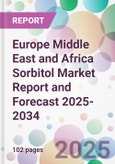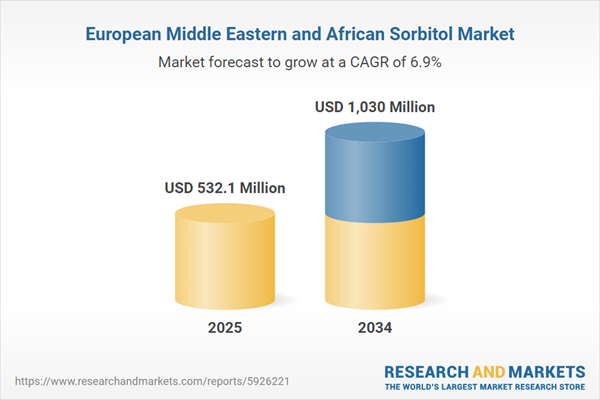Thus, the Europe Middle East and Africa sorbitol market adds to the global market growth which is projected to grow at a CAGR of 2.4% in the forecast period of 2025-2034. Western Europe, especially, represents the largest market in the Europe Middle East and Africa region. It is also a leading market, globally, and was the third largest producer of sorbitol in the world. The Western European country, Germany, is one of the leading global exporters of the polyol.
The global market for the polyol is being driven by its expanding application sectors. The polyol finds one of its leading application in toothpaste where it primarily acts as a sweetening agent that does not harm the teeth. The growing food and beverage industry is providing an impetus to the industry growth, especially with the rise in the diet food and beverage segment. The growing health awareness among the consumers with the increase in the number of people afflicted by conditions like obesity and type-2 diabetes, the industry is further projected to grow. The polyol is also increasingly being used to produce Vitamin C.
Corn is a leading feedstock for sorbitol globally. In Western Europe, over three-fourths of the polyol is produced from corn. In the European Union, an estimated 63 million metric tons of sorbitol was produced between 2018-2020, which was an increase of 1% from the previous year. The overall yield in the period is estimated to be 7.62 tons per hectare, which is an increase of 3% from the past year. Despite the drought in the summer of 2018, the corn output was better than expected in countries like France, Germany, Hungary, and Poland. Between October 2016 to July 2017, Ukraine exported its surplus corn production to countries like Egypt. It exported 3.34 million metric tons of corn to Egypt in the period and was the major corn exporter to the African country. Wheat is also a significant feedstock in Europe.
Market Segmentation
The report titled “Europe Middle East and Africa Sorbitol Market Report and Forecast 2025-2034” offers a detailed analysis of the market based on the following segments:Market Breakup by Type
- Liquid Sorbitol
- Powder Sorbitol
Market Breakup by Application
- Pharmaceuticals
- Toothpastes
- Food & Confectionaries
- Cosmetics & Toiletries
- Industrial Surfactants
- Others
Market Breakup by Region
- Germany
- France
- United Kingdom
- Saudi Arabia
- Nigeria
Market Analysis
The Europe Middle East and Africa sorbitol market is being driven by the growing application of the polyol within the food and beverage sector. The food and beverage segment in the region is being driven in the area by young consumers with increasing spending power, who are also increasingly becoming health and diet conscious. These young consumers are seeking out convenient, healthy, and easy-to-prepare food, RTD beverages, and other snacks, which often contain sorbitol.Germany, a leading sorbitol market in Europe, has a thriving food and beverage industry. The country is the largest food producer in the continent with the food and beverage sector being the fourth largest industry in Germany. Some of the leading sub-segments within the sector in the country are baked goods, and confectionery and long-life bakery products, which together account for over 15% of the food and beverage sector. The growth in these sectors provides a further impetus to the industry for sorbitol in Germany. With various R&D undertaking by the major players in the food and beverage industry in the country, the market for the polyol is expected to grow further in Germany.
The Europe Middle East and Africa sorbitol market is also being aided by the growing cosmetics sector in the region. The polyol is added to various cosmetics items as a humectant and flavouring, binding, and conditioning agent. It is also added to hair products to soften the hair. The cosmetic industry is also witnessing a surge in the continent in grooming products targeted towards men. This expansion of the cosmetics industry is also aiding the sorbitol industry growth. The cosmetics industry in the Middle East and Africa is also aiding the market, especially, the cosmetics industry in countries like Saudi Arabia, Iran, and UAE. The cosmetics industry in Africa is being driven by the growing middle class in the continent whose size has tripled in the last three decades. The resultant increase in urbanisation is also aiding the Europe Middle East and Africa sorbitol market.
Competitive Landscape
The report gives a detailed analysis of the following key players in the Europe Middle East and Africa sorbitol market, looking into their market share, capacity, and latest developments like expansions of capacity, mergers and acquisitions, and plant turnarounds:- Roquette Frères SA
- Cargill, Incorporated
- Ingredion, Incorporated
- Archer Daniels Midland Company
- Tereos Starch & Sweeteners
- Others
Table of Contents
Companies Mentioned
The key companies featured in this Europe Middle East and Africa Sorbitol market report include:- Roquette Frères SA
- Cargill Inc.
- Ingredion Inc.
- Archer Daniels Midland Company
- Tereos Participations
Table Information
| Report Attribute | Details |
|---|---|
| No. of Pages | 102 |
| Published | August 2025 |
| Forecast Period | 2025 - 2034 |
| Estimated Market Value ( USD | $ 532.1 Million |
| Forecasted Market Value ( USD | $ 1030 Million |
| Compound Annual Growth Rate | 6.9% |
| Regions Covered | Africa, Europe, Middle East |
| No. of Companies Mentioned | 6 |









